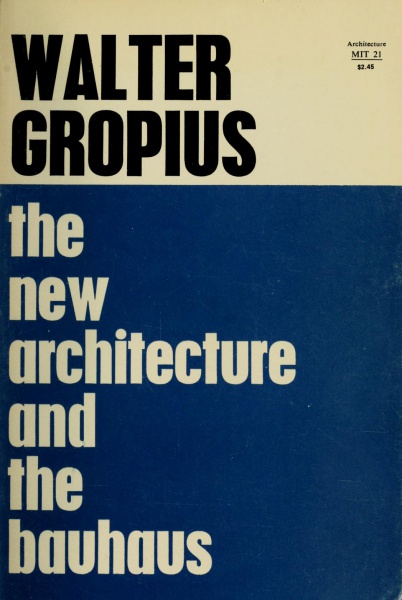Reyner Banham: Theory and Design in the First Machine Age, 2nd ed. (1960/1967)
Filed under book | Tags: · 1900s, 1910s, 1920s, aesthetics, architecture, art, art history, avant-garde, bauhaus, de stijl, design, design history, functionalism, futurism, history of architecture, industrial design, machine, technology

First published in 1960, Theory and Design in the First Machine Age has become required reading in numerous courses on the history of modern architecture and is widely regarded as one of the definitive books on the modern movement. It has influenced a generation of students and critics interested in the formation of attitudes, themes, and forms which were characteristic of artists and architects working primarily in Europe between 1900 and 1930 under the compulsion of new technological developments in the first machine age.
Publisher Praeger, New York and Washington, 1960
Second edition, 1967; Second printing, 1970
338 pages
Review (Robert Gardner-Medwin, The Town Planning Review, 1961)
Review (Dennis Young)
Review (Caroline S. Lebar, 2012)
Review (of the 2009 French edition, Hugues Fontenas, Critique d’art, 2010, in French)
Commentary (Gillian Naylor, Journal of Design History, 1997)
Commentary (Nigel Whiteley, 2005)
PDF (50 MB, no OCR)
Comment (0)Walter Gropius: The New Architecture and the Bauhaus (1935/1965)
Filed under book | Tags: · architecture, art, avant-garde, bauhaus, design

In this short book, first published one year after his emigration to England, Gropius presents the ideas of the Bauhaus, which had been closed and banned in Germany, to an Anglo-Saxon and American audience. The book contributed considerably to Gropius’ rise to a celebrated architect – particularly in the US – and introduced the Bauhaus to America. “When he came to Harvard in 1937, he did refer to the exemplary American building industry, which had no equal, but he also pointed out that he did not want to teach Americans what American architecture should look like, and that he most certainly did not want to introduce a European style. This was exactly what he attempted and finally did, of course, as he believed that architecture had to express the forces of the present time like the members of the Neues Bauen [New Building] with himself at their head had shown in the 1920s.” (Nerdinger). This volume, in which the architect looks back on his work in Weimar and Dessau, reveals the foundations of the self-confidence expressed here.
Translated by P. Morton Shand from the German manuscript entitled Die neue Architektur und das Bauhaus. Grundzüge und Entwicklung einer Konzeption
With an Introduction by Frank Pick
First published by Faber and Faber, London, 1935
Publisher The MIT Press, 1965
ISBN 0262570068
112 pages
Review: Herbert Read (Scrutiny, 1935)
PDF (4 MB, updated on 2019-9-13)
Comment (0)Ulrich Conrads (ed.): Programs and Manifestoes on 20th-Century Architecture (1964/1970)
Filed under book | Tags: · architecture, art, avant-garde, bauhaus, city, constructivism, functionalism, manifesto, modernism, neoplasticism, utopia

“The present volume offers eloquent testimony that many of the master builders of this century have held passionate convictions regarding the philosophic and social basis of their art. Nearly every important development in the modern architectural movement began with the proclamation of these convictions in the form of a program or manifesto. The most influential of these are collected here in chronological order from 1903 to 1963. Taken together, they constitute a subjective history of modern architecture; compared with one another, their great diversity of style reveals in many cases the basic differences of attitude and temperament that produced a corresponding divergence in architectural style.
In point of view, the book covers the aesthetic spectrum from right to left; from programs that rigidly generate designs down to the smallest detail to revolutionary manifestoes that call for anarchy in building form and town plan. The documents, placed in context by the editor, are also international in their range: among them are the seminal and prophetic statements of Henry van de Velde, Adolf Loos, and Bruno Taut from the early years of the century; Frank Lloyd Wright’s 1910 annunciation of Organic Architecture; Gropius’s original program for the Bauhaus, founded in Weimar in 1919; “Towards a New Architecture, Guiding Principles” by Le Corbusier; the formulation by Naum Gabo and Antoine Pevsner of the basic principles of Constructivism; and articles by R. Buckminster Fuller on universal architecture and the architect as world planner. Other pronouncements, some in flamboyant style, including those of Erich Mendelsohn, Hannes Meyer, Theo van Doesburg, Oskar Schlemmer, Ludwig Mies van der Rohe, El Lissitzky, and Louis I. Kahn. There are also a number of collective or group statements, issued in the name of movements such as CIAM, De Stijl, ABC, the Situationists, and GEAM.
Since the dramatic effectiveness of the manifesto form is usually heightened by brevity and conciseness, it has been possible to reproduce most of the documents in their entirety; only a few have been excerpted.”
First published as Programme und Manifeste zur Architektur des 20. Jahrhunderts by Verlag Ullstein, Frankfurt/M and Berlin, 1964.
Translated by Michael Bullock
Publisher MIT Press, 1970
ISBN 0262530309, 9780262530309
192 pages
via carlao126
PDF (4 MB)
See also Charles Jencks, Karl Kropf (eds.), Theories and Manifestoes of Contemporary Architecture, 1997.
Comment (0)
